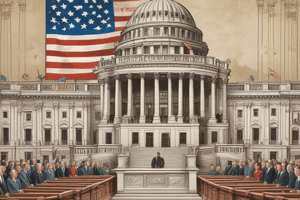Podcast
Questions and Answers
What is the primary role of the legislative branch of the federal government?
What is the primary role of the legislative branch of the federal government?
- To create laws and approve the federal budget (correct)
- To interpret laws and determine their constitutionality
- To oversee foreign relations and treaties
- To enforce laws and ensure compliance
Which of the following best describes the system of checks and balances?
Which of the following best describes the system of checks and balances?
- A mechanism to prevent any single branch from gaining excessive power (correct)
- A structure where the executive branch has ultimate power over the other branches
- A process requiring voter approval for all congressional actions
- An agreement among the states to share power equally
What is one major power of the executive branch?
What is one major power of the executive branch?
- Establishing state laws
- Deciding on election candidates
- Vetoing legislation passed by Congress (correct)
- Appointing Supreme Court justices without consent
Which of the following is a responsibility of the judicial branch?
Which of the following is a responsibility of the judicial branch?
What role does Congress play in the federal government?
What role does Congress play in the federal government?
Which of the following accurately describes a function of the federal government?
Which of the following accurately describes a function of the federal government?
What is a limitation of the power of the federal government?
What is a limitation of the power of the federal government?
Which principle of governance restricts the federal government's power?
Which principle of governance restricts the federal government's power?
In which area does the federal government have the exclusive power?
In which area does the federal government have the exclusive power?
What mechanism allows the federal government to ensure compliance with its laws?
What mechanism allows the federal government to ensure compliance with its laws?
Which branch of the federal government is primarily responsible for interpreting laws?
Which branch of the federal government is primarily responsible for interpreting laws?
Which principle of government ensures that each branch of the federal government operates independently?
Which principle of government ensures that each branch of the federal government operates independently?
What is the primary mechanism by which Congress influences the federal budget?
What is the primary mechanism by which Congress influences the federal budget?
Which of the following actions can the President take that does NOT require Congressional approval?
Which of the following actions can the President take that does NOT require Congressional approval?
In which circumstance would the judicial branch primarily come into play?
In which circumstance would the judicial branch primarily come into play?
Flashcards are hidden until you start studying
Study Notes
Government Structure and Function
- The United States operates as a federal republic, where power is divided between a central (federal) government and individual states.
- This division of power is defined in the US Constitution.
- This document establishes the three branches of the federal government: Legislative, Executive, and Judicial.
- Each branch has unique responsibilities and checks and balances to prevent one branch from accumulating too much power.
- The US system of government is intended to ensure a balance of power, protect individual liberties, and enable a representative form of governance.
Structure and Function of the Federal Government
- The Federal Government is divided into three branches: Legislative, Executive, and Judicial.
- The Legislative Branch makes laws.
- The Executive Branch enforces laws.
- The Judicial Branch interprets laws.
- The Federal Government is responsible for national defense, interstate commerce, and foreign policy.
- The Federal Government derives its power from the United States Constitution.
- Powers not delegated to the Federal Government are reserved to the States.
- The Federal Government is a system of checks and balances, ensuring no one branch becomes too powerful.
- The Federal Government operates through a system of elected officials.
- The Federal Government interacts with state and local governments.
- The Federal Government is responsible for providing certain services to citizens, such as Social Security and Medicare.
- The Federal Government is subject to public scrutiny and accountability.
The Federal Government – Structure and Function
- The U.S. government is a federal system, meaning power is shared between the national government and state governments.
- The Constitution outlines the structure and functions of the federal government.
- The federal government is divided into three branches: legislative, executive, and judicial.
- The legislative branch makes laws.
- The executive branch enforces laws.
- The judicial branch interprets laws.
- The legislative branch is composed of Congress, which is made up of the Senate and the House of Representatives.
- The executive branch is headed by the President, who is elected every four years along with their Vice President.
- The judicial branch is made up of the Supreme Court and the federal court system.
- The federal government has a number of important responsibilities, including regulating interstate commerce, declaring war, and maintaining a national currency.
- The federal government is also responsible for providing certain services to its citizens, such as education, healthcare, and social security.
Studying That Suits You
Use AI to generate personalized quizzes and flashcards to suit your learning preferences.




